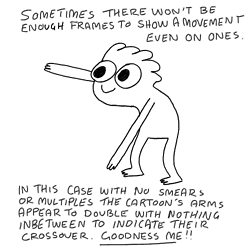The Blue Umbrella – Story Reel and Short
December 10, 2013
Making of Hotel Transylvania
March 14, 2013
Following yesterday’s post on smear shapes in animation, here’s a behind-the-scenes of Hotel Transylvania from It’s Art Mag. This film has got the most ‘pushed’ poses I’ve seen in recent memory.
(Spoiler Alert: It also gives away one of the big reveals in the show!)
Smear frames in animation
March 13, 2013
Check here for a collection of smear frames and explanations of their uses. The above gif is part of a larger piece found on page 20 at the time of posting.
And the nominees are…
February 4, 2010
Only twice ever has an animated film been nominated for Best Picture, once for Beauty and the Beast, before they created the Animated Feature category. And now we have Up, nominated for both Best Picture and Best Animated Feature.
Incredible! I’m hoping this will educate the public further in animation – we’re not just sitting in front of computers and clicking , there’s acting and performance involved
Workflow methodologies
February 2, 2010
Of the many methods used for blocking animation, stepped mode is probably my favourite. You concentrate on making strong poses, then getting the timing right, then getting the breakdowns to read clearly, and even before you get into spline, the whole performance can already be finessed to a high level, all without even touching the graph editor.
Its linear, predictable, and gives me all the control I need.
Things get trickier once complex movements kicks in, because the weight and force of the motion is critical, and despite the amount of control stepped mode gives me, it can be hard to judge how the weight reads when it goes into spline. This is when I use a combination of layered and stepped mode for the quickest results.
Starting with the root of the character – typically the hips, I’ll animate the entire motion in spline. Just the hips, nothing else. I’ll have the legs hidden and concentrate on getting the force and weight of the motion right. Because it’s in spline there’s no surprises later, whatever I see now will be what I get when I get the rest of the body moving. It’s a simple matter of placing the feet where it needs to be for it to sync with the hips movement, there will be some back and forth of course but most of the work (the hips) is already done. There’s no need to second guess yourself if you’ve screwed up the weight or not.
The video reference comes in next, at this stage I’ll usually key every control on the character every 4th frame, then convert the whole animation to stepped. Back to stepped? Yes, the whole point of animating the hips first in spline is to get the weight right. Now that that’s done I move back into step and make sure that all the strong poses I have in my video reference is in, and push those poses that isn’t strong enough more. This doesn’t meant this the first time I’m actually referencing my video, I use it when animating I’m the root of the character in spline, just to be sure I don’t veer too far off from what I want. I’m simply pushing the poses and adding in the rest of the character, having the whole piece in stepped mode is just the way I do it. I could do it in copied pairs too, I’m just more comfortable with stepped in this case.
Once that part is done I’ll move the whole animation into spline, if I haven’t screw too much with the hips in stepped, it should look fairly close to what I had previously. This is critical, losing the weight and force of the movement after going into spline is very common if the blocking wasn’t done properly. And even then chances are it’ll still be a little off, you’ll spend most of the time trying to fix this. If you’ve done it properly in spline earlier, that’s a lot of the work done. It’s mostly just the legs and making sure the torso has enough torque, compression, and decompression. And unless you have the arms playing a large part in the animation (climbing and whatnot) it’s just polishing and finessing it from here now. If the arms are important to the overall motion, I’ll start getting them involved during the hips animation. Not the whole stretch of the animation, just the part where the source of the force changes from the hips to the arms. Earlier I mentioned animating the root of the character, now that the arms are pulling the character up, the root is no longer the hip, its the arms and we need to readjust the animation accordingly.
I still prefer the full stepped mode method for performance, usually because you don’t move around as much, hence easier to get the weight right even in stepped. I’ll be animating a new piece of animation for my next assignment from Animation Mentor soon, maybe I’ll experiment using the spline/stepped combo method for that. It’s a two character performance piece, but it should still work well enough. Lets see how that goes.





